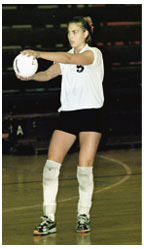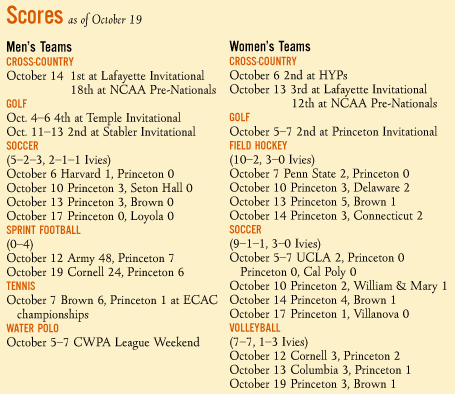November 7, 2001: Sports
Ghosts
of losses past haunt Tigers
Football falls to Brown, Harvard
Setting
the standard
Following PrincetonÍs lead, Ivy volleyball improve2
Sports Web Exclusives! The Varsity Typewriter a PAW web exclusive column by Patrick Sullivan '02
Ghosts
of losses past haunt Tigers
Football falls to Brown, Harvard
By Jerry Price
The view from the top of the stadium facing downtown Boston is breathtaking, especially on a crystal clear fall afternoon. To the left sits the Charles River and then Cambridge, creating a setting from the ancient coliseum that is simply idyllic. Harvard Stadium is as old as it is picturesque. It is the oldest football stadium in America, a fact you can tell in an instant as you enter.
It takes slightly longer, somewhere between 59 and 60 minutes to be exact, to tell that this venerable, peaceful building on the banks of the Charles is actually haunted, at least from the perspective of the Princeton football team. “Sometimes things don’t go the way you want,” said Princeton running back Cameron Atkinson ’03 after his Tigers fell 28—26 to Harvard on Oct. 20.
Especially for Princeton at Harvard Stadium. The recent history lesson begins in 1997, when Princeton lost 14—12 on a safety and four field goals, the last of which grazed the crossbar as it went across. That was followed in 1999 by a 13—6 loss in which Princeton first tied the game on a 52—yard Taylor Northrop ’02 field goal and then lost it on a touchdown run from inside the one-yard-line as time expired.
But those two games were merely setting the stage for 2001.
Harvard came into this year’s game unbeaten and hoping to cruise into a showdown with fellow-unbeaten Penn in November. The game against Princeton certainly started out innocently enough, as the Crimson built a 14—3 lead and seemed headed for another touchdown. But Chris Roser-Jones, returning from a hamstring pull that cost him two games, turned the entire day around by intercepting a pass (the 11th of his career, unheard-of for a linebacker) and returning it 40 yards to the Crimson 15. The pick started a stretch of Crimson turnovers and short Princeton scoring drives that turned that 14—3 deficit into a 20—14 Princeton lead at halftime.
Harvard scored twice to retake the lead at 28—20 early in the fourth quarter, but Atkinson’s 27-yard touchdown run made it 28—26. Harvard’s Willie Alford slapped away the two-point conversion attempt, however, and Princeton still trailed by two.
After the teams traded punts for three possessions, Princeton took over on its 12 with 2:57 to go. Quarterback David Splithoff ’04, completing five straight passes, drove his team to the Harvard 32 with seven seconds remaining, and Northrop lined up for a 49-yard field goal attempt that would have won the game. Instead, the All-America kicker missed just wide left, and Harvard escaped once more.
“It felt good when I hit it,” Northrop said. “I kept my head down. When I looked up, I was stunned. I was just stunned. I thought it was good.”
The loss was Princeton’s sixth in a row to Harvard, the longest streak of the two teams’ series, which dates to 1877. Harvard had an earlier winning run of five games from 1912 to 1916.
The Harvard loss was preceded seven days earlier by a 35—24 loss at Brown. Atkinson’s career-best 146 rushing yards against Brown included two touchdowns, and Princeton led 24—21 in the fourth quarter before burly Brown tailback Michael Malan took over. By game’s end, Malan had 206 rushing yards and the Bears had handed the Tigers their first Ivy League loss.
That loss put an increased sense of urgency on the Harvard game. “The effort was there both weeks,” head coach Roger Hughes said. “We’re getting there. I couldn’t be happier with the effort of every single person in the program. We just have to get one of these one day.”
Watching this group of young
Tigers, you get the feeling his team will break though. Whether or not
it will be at Harvard Stadium is a question for the ghosts who have haunted
the place for the Tigers. ![]()
Jerry Price is assistant director of athletic public affairs.
 Setting
the standard
Setting
the standard
Following Princeton’s lead, Ivy volleyball improves
By Josh Stephens ’97
Caption: Setter Ana Yoerg is the lone senior for the Tigers, who are facing increased league competition. (Photo: Beverly Schaefer)
In 1994 the NCAA began offering the Ivy League champion an automatic bid to the women’s volleyball tournament. At the time, the Ivies were unknown and untested beyond their immediate region, and it’s debatable whether they even deserved a bid; UC—Santa Barbara dispatched the Tigers with little trouble.
Six years later, Princeton faced eventual undefeated national champion Nebraska in the first round of NCAAs. The Tigers didn’t exactly upset the top-seeded Huskers, yet one of the best college teams in history needed an hour and 20 minutes to complete its 15—9, 15—2, 15—7 victory; Princeton impressed Nebraska coach John Cook by being “competitive and well-coached.” It was a small score to a team like Nebraska, but a giant leap for the Ivy League.
Compared to 20 or even 10 years ago, “it’s night and day,” says 20-year coach Glenn Nelson. “The league is solid. Somebody is letting a lot of volleyball players in.”
One constant through the derision and indifference has been Princeton, which has captured 12 Ivy titles and kept afloat a volleyball backwater where strong teams sometimes didn’t break a sweat and weaker teams turned would-be benchwarmers into stars.
“The teams we played in the Ivy League were comparable to high school teams,” says Kristin Spataro ’96, who set her Orange County club team to a national championship in 1992. “There were several that would not have been able to compete at the club level,” which is generally stronger than high school.
This season the Tigers hope to claim their third title in a row, but to do so, they must beat teams that are looking a little more like the Huskers and a lot less like high school.
Tim Jensen, director of the elite Sports Shack club in Los Angeles and assistant coach for 13th-ranked Pepperdine, says that the league is “improving at a drastic rate. Ivy coaches are working hard, recruiting hard, and doing the best they can without scholarships. It’s definitely not the weakest league in the NCAA.”
Though top prospects still tend to sign letters of intent with scholarship schools, such as Stanford, Duke, or UC—Berkeley, before they even receive their Princeton applications, of late the league has begun to attract best of the rest, and even the occasional superstar.
Harvard coach Jennifer Weiss says that she and her colleagues are recruiting more aggressively than ever before, and Jensen confirms that he sees Ivy coaches at all the big club tournaments. The result is that almost every current Ivy starter boasts high school accolades – team MVP; team captain; all-region; regional championships; and state championships – and six-footers, such as Princeton setter Ana Yoerg ’02, are becoming commonplace.
Harvard freshmen Kaego Ogbechie and Pernilla Schweitzer may represent a breakthrough for the league. According to Jensen, both were nationally recognized last year and could have gone to top programs. “The volleyball is now good enough that we can’t not recruit those kids,” says Harvard’s Weiss.
Nevertheless, all that recruiting has amounted to little to date for all but the Tigers. Though Brown won in 1996 and 1998, Princeton has since 1994 quite breathlessly set – and raised – the standards for the rest of the league.
But this year, as others have improved, Princeton fields a young, inconsistent squad that may have to play harder than ever.
With as many as three freshmen on the court and an injury to opposite Michelle Buffum ’03, Yoerg, the lone senior, says, “It’s a weird season.” Outside Kellie Cramm ’04 calls it “a little scary.”
For the Tigers, “weird” and “scary” apply to any season in which they are not the clear favorite, and this is such a season. “The league title is going to be a challenge,” said Yoerg. “Everyone is out to get us. They don’t like us at all, not that they ever did.”
Nelson does not promise a three-peat; rather, he says, “every team is capable of beating everyone else.” Penn proved Nelson’s point with a 30—26, 30—22, 28—30, 30—17 win over the Tigers in both teams’ league opener. Princeton dropped subsequent matches to Cornell and Columbia to start 0—3 in the league.
Yoerg considers Cramm a “rock star” on the left side, and 6'4" middle Abby Studer ’03 is an imposing presence at the net, but no other Tigers are consistently putting balls away. Errors plague the Tigers’ serve receive and defense.
Still, Nelson sees plenty of talent in his young crop, and, according to Yoerg, competing for the league title is more a matter of attitude than talent.
“The challenge is to
get everyone on the same page and make sure that everyone knows that every
game counts,” said Yoerg.![]()
Josh Stephens ’97 covered volleyball for the Daily Princetonian.

![]()
